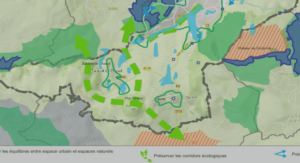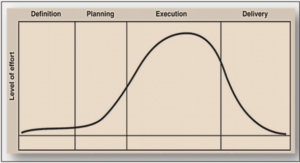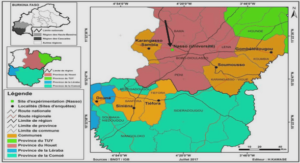Comparison of plant communities on two
massifs in Madagascar
Study area
Ibity and Itremo, the only quartzitic mountain massifs in Madagascar, are located in the central highlands southwest of the capital city, Antananarivo. Ibity Massif is situated 25km south of the town of Antsirabe (47°01’E 20°07’S) and is oriented approximately north-south, covering an area of 193km² and an elevational range of 1400m to 2254m. Itremo Massif, located 200km southwest of Ibity and 35km west of Ambatofinandrahana (46°38’E 20°35’S), covers 971km2 and ranges from 1400m to 1923m elevation. The climates of the Ibity and Itremo regions are characteristic of tropical highlands, classified as Cwb by the Köppen classification system (Köppen 1900; Peel et al. 2007), with warm weather, dry winters and rainy summers. Two main periods can be distinguished: in summer (November-May) the maximum average temperature is around 25°C and the minimum is at least 12°C. In winter (June-Octobre), the minimum average temperature often oscillates around 0°C. Average annual rainfall is 1583mm at Ibity and 1416mm at Itremo (based on data from 1961 to 1990; Meteorology Service of Ampandrianomby). The soils of the Ibity massif are ferrallitic and classified as lithosols on quartzitic substrate, mainly formed of metamorphic rocks of the 61 schisto-quartzo-calcareous series. A small area of granite, covering less than 5% of the total mountain, is found on the northeast slope (Birkinshaw et al. 2006). Ibity reaches 2254m in elevation, the highest quartzitic mountain in Madagascar. The soil of Itremo massif, classified as lithosols on quartzitic substrate, is mainly formed of schist-quartzitic rocks and has the largest area of exposed quartzitic substrate in Madagascar (Birkinshaw et al. 2004). The highest point of Itremo is 1923m above sea level.
Vegetation sampling
Seventeen fragments of tapia woodland (hereafter referred to as sites) were selected for study, ten at Ibity (seven on quartzitic and three on granitic soil, reflecting the relative area covered by these two soil types) and eight at Itremo (five on quartzitic and three on granitic soil). The sites were classified as being quartzitic or granitic according to the simplified geology map of Du Puy and Moat (1996, 1998). Most of the existing tapia fragments in each massif were studied, with the exception of just a few that were difficult or/and dangerous to access. On Ibity three of the four fragments located on the granitic soil and seven of the ten on the quartzitic soil were studied. On Itremo three of the five fragments on the granitic soil and five of the eight fragments on quartzitic soil were studied. In order to sample vegetation composition and structure in tapia woodland we used a method adapted from Fukushima et al. (2008) and Kull et al. (2005). At each site, we randomly established three 40×40m plots. In tapia fragments of limited size, only one or two plots were marked. In each 40×40m plot, all individuals with a diameter at breast height (DBH) of more than 10cm, i.e., those that comprise the canopy, were recorded and measured; within each of the large plots, a 20×20m subplot was established (Figure II-1) within which all individuals with a DBH of 5-10cm (lower canopy) were measured. Similarly, a 10×10m plot was also established within which all the individuals with a DBH between 1-5cm (midstory) were measured, along with a 5×5m plot in which individuals with a height lower than 1.30m or a DBH between 0-1cm (understory) were measured. For herbaceous species, 16 1×1m plot were randomly established at each site. In total, for both massifs, 43 plots measuring 40×40m were delimited in tapia woodland along with 255 plots of 1m×1m in the herbaceous stratum. For each individual, canopy cover (m²) and total height were estimated, and DBH was measured. For herbaceous species the percent cover of each taxon in each of the 1m² quadrats was 62 assessed. Sampling was carried out between June and August 2009. Species identifications were confirmed in Antananarivo at the reference herbarium of the Tsimbazaza Botanical and Zoological Park and at MBG’s offices. Figure II-1: Arrangement of sampled plots in tapia woodland: 40×40m plot (for trees of DBH ≥ 10cm), 20×20m plot (for trees of DBH 5-10cm), 10×10m plot (for trees of DBH ≥ 1-5cm), 5×5m plot (for trees of DBH < 1cm) and five of the 16 1×1m random plot (for herbaceous species).
Statistical analyses
To assess differences in species richness (response variable) between the two massifs and the two main soil types (quartzitic and granitic) along with possible interactions between these factors, species richness data were analyzed with linear mixed effect models using the lme function (Pinheiro & Bates 2000), R-package nlme). The sites and the plots at each site were treated as random factors to account for both differences in soil type and statistical dependence between measurements for different species in the same plot. They were checked for a normal distribution using the Lilliefors test and square root transformations were made as necessary. The homogeneity of variance was confirmed with the Bartlett test. We expected species richness to be higher on the quartzitic soil because some species are restricted to this substrate; we also expected richness to be higher at Itremo because the vegetation on the massif seemed less heavily impacted. To evaluate differences in the composition of tapia woodland areas, a Correspondence Analysis (CA) was carried out on on percent covers of each species. We expected to find some patterning in species composition depending on the soil and the massif. 40×40m kdjc 20×20m 10×10m 5×5m 1×1m 63 To estimate differences in tapia woodland structure between massifs and between soil types, as well as possible interactions between these factors, linear mixed effect models with the lme function were used as above on three response variables: height, percent cover, and DBH of Uapaca bojeri and all other woody species. We expected these variables to be higher at Itremo because the surrounding area is less densely populated and also higher on granitic soils because they are generally richer in nutrients. Then, two variables, the height of individuals > 1m and the DBH (response variable) of Uapaca bojeri and all other woody species, were divided into classes to characterize the distribution of woody species within tapia woodland. Kruskal-Wallis tests followed by Wilcoxon tests adjusted by a Bonferroni correction were run to assess differences between classes for each massif separately. To determine differences between the two massifs for each DBH and height class, additional Wilcoxon-tests were run. Again, we expected values to be higher at Itremo and on granitic soil. To determine differences between the two massifs for each DBH of common woody species, t-test or Wilcoxon-tests were run. All analyses were carried out using the software R (The R Foundation for Statistical Computing, version R2.13.0).
Results
Species richness in Ibity and Itremo
We found a total of 120 and 84 species at Ibity and Itremo, respectively, belonging to 41 and 26 families and 83 and 60 genera. Woody species richness was significantly lower on granitic soil at Itremo (2.5±0.62 species); it was intermediate on quartizitic soil at Itremo (5.7±0.65 species), and highest for both soil types at Ibity (7.9±0.38 species) (Fsoil×massif=8.4, p<0.01; Figure II-2a). The species most closely associated with Uapaca bojeri (the dominant tree element) at both Ibity and Itremo include members of Sarcolaenaceae (Leptolaena pauciflora, Pentachlaena latifolia, Sarcolaena oblongifolia, Schizolaena microphylla, Xerochlamys bojeriana, and X. diospyroidea), Aphloia theiformis (Aphloiaceae), two species of Asteropeia (A. densiflora and A. labatii – Asteropeiaceae) and Schefflera bojeri (Araliaceae). Species richness of the herbaceous stratum was lower on Itremo quartzitic soil (5.6±0.23 species) than on other combinations of site and soil type (6.5±0.16 species; Fsoils×massifs=14.5, p<0.001; Figure II-2b).



